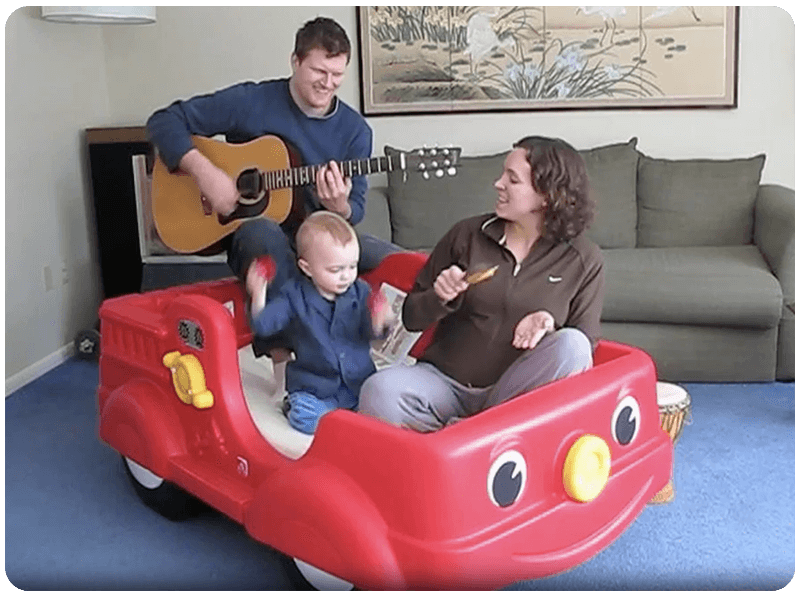There are so many aspects of parenting that are fun: witnessing first milestones; seeing your child laugh as they begin to discover life; and of course, the snuggles during Music Together® lullabies! But, we’ve all had those days: “Put on your socks,” “Get in the car,” “Eat your peas…” and it just doesn’t happen without a hassle. Sometimes we can feel stuck if our children don’t want to come along for the ride. Well, there is one way to ease this stress–and maybe encourage your children to switch gears and do what they need to do. Try singing!
Share the feeling
Believe it or not, your child (in general) wants to do what you’re doing. It turns out that young children are hard-wired to pick up on their grownups’ facial cues and intuit their emotional responses to events. In other words, distress and frustration make more distress and frustration. BUT, it also means that if you start singing, your child will most likely pay attention, and therefore have a model of something else to imitate.
Following your lead is not only biological, it’s also educational. Author Ellen Galinsky, in the book Mind in the Making, says, “Imitation accelerates learning and multiplies learning opportunities.” If you can switch gears and start singing to your child, they might just take your cue and follow along.

Shifting focus
Shifting focus by singing about the activity you want to encourage, like, “Let’s put on our shoes now…” might seem hard, but if you’ve been in Music Together class, you’ve already experienced it. Your teacher has most likely demonstrated how so many Music Together songs are adaptable to everyday tasks and situations.
Take the song “Biddy Biddy” (available to stream for free on your favorite music player app). In class you might have sat on the floor with egg shakers singing different sounds and syllables. But on another day, you might have sung, “Brushing, brushing, brushing…” as you made the motions of brushing your teeth–or, “Combing, combing, coming…” as you pretended to comb your hair. Likewise, in the song, “Ridin’ in the Car,” (available on the free Music Together app), you probably not only sang, “Zoom, zoom, ridin’ in the car,” but also sang about different things you (and your child) do in the car, such as, “buck-buck-buckling up,” as you click yourself into your imaginary car seat. or “Wave, wave, wavin’ to a friend…” etc.
Try singing about what you’re doing when your child needs a little encouragement to get the job done! Through playful music, you can help your child focus AND shift your own attention from the stress you may be feeling as you try to get your child to complete the current task.
Practice makes progress
You’ve probably heard your Music Together teacher talk about the importance of playing and singing your Music Together songs at home. Familiarity with the songs can deepen your child’s music learning and help them (and you) participate more in class and have more fun.
And now you have gotten a glimpse into another reason to take your music home with you: to practice adapting songs to match your child’s daily routine! Using concrete examples of musical activities from your class at home during the day allows you and your child to practice singing through daily activities. Slowly, over time, you might find yourself adapting songs on your own with more confidence and ease. And that just might pay off for your child. And for you, too.

To wrap it up
As much as practicing these skills is important, music is also fun! Just the act of singing in and of itself can be rewarding. Make sure you’re singing when you’re having fun with your child, too–not just during the stressful times. Keep coming to class with your family and show your child that music-making can be a part of every day. As for the tough parts of the day when you just can’t seem to get your child on board, try singing about it and see how it goes. You can do it! And don’t forget the ways your brain changes when you make music. More of that to come in the next blog post. Stay tuned and happy singing!



